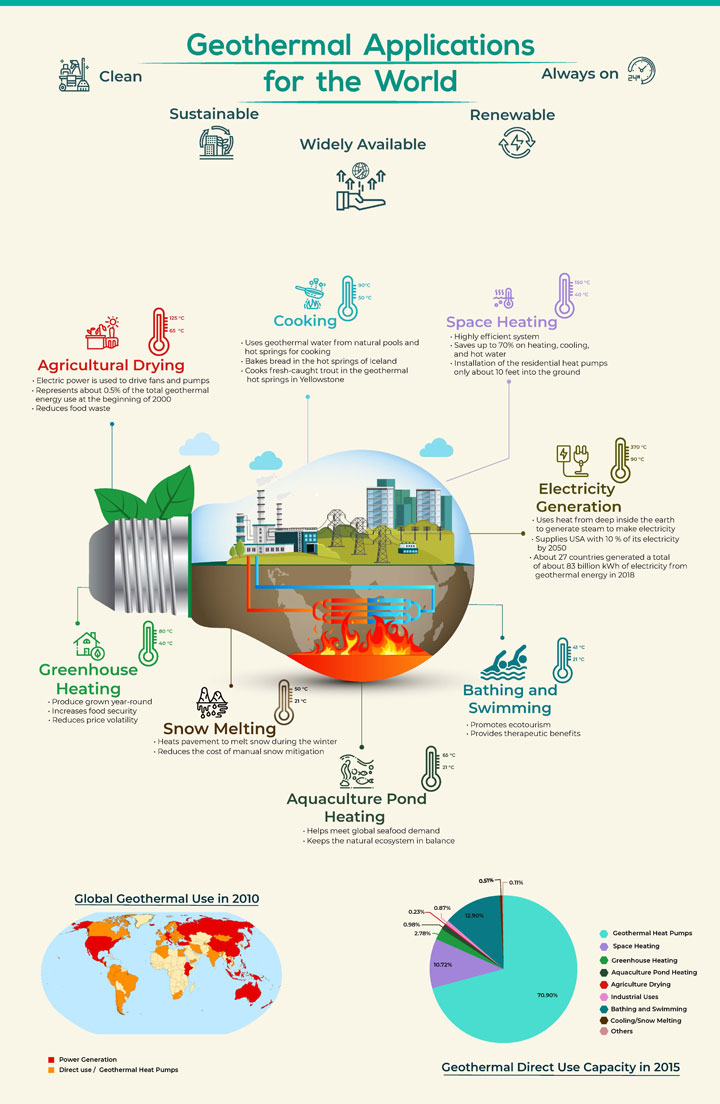Students Shed Light on Deep-Down Geothermal Benefits in Infographic Design Challenge
Last fall, the U.S. Department of Energy (DOE) Geothermal Technologies Office and the National Renewable Energy Laboratory (NREL) engaged college students to unearth a true buried treasure: geothermal energy.
The Fall 2020 Geothermal Design Challenge™ asked students to tackle an important communications task—create infographics and data visualization to foster understanding of geothermal energy, broadly communicate its benefits, and help overcome key non-technical barriers to geothermal development. Students from across the United States designed powerful, high-quality infographics to illustrate aspects of geothermal energy production, backed by robust technical data and accompanied by communications and outreach strategies to maximize impact.
Three submissions stood out among the pack.

In first place, the University of North Dakota (UND) Thermal Vision team's "Geothermal Applications for the World" print infographic highlights the benefits and worldwide use of eight common applications of geothermal energy: agricultural drying, cooking, greenhouse heating, aquaculture, electricity generation, space heating, snow melting, and bathing and swimming. The UND team includes graduate geophysics researcher Moones Alamooti, Ph.D., petroleum engineering Ph.D. student Jerjes Porlles Hurtado, and Jessica Eagle-Bluestone, who holds a master's degree in petroleum engineering.
Team member Alamooti credits both UND and the challenge reviewers in positively shaping their submission.
"We have an excellent geothermal program at the University of North Dakota under Dr. Will Gosnold's supervision," Alamooti said. "It was very important for our multidisciplinary team to share the knowledge that we learned with other people to not only raise awareness about this renewable resource but also to boost engagement. The Geothermal Design Challenge gave our team a platform to accomplish our goal in a very effective way, especially after the constructive feedback that we received following our first entry."
The University of California, Santa Cruz Geo Slugs won second place with "Green & Unseen: The Future of Geothermal Power," a digital infographic highlighting new developments in geothermal energy, with a focus on how large- and small-scale systems benefit people, businesses, and the planet through renewable electricity, district heating, and more.
In third place, students from Antelope Valley College created "The Heat Beneath Our Feet," an infographic that describes how geothermal heat pumps are a cost-effective solution for residential heating and cooling.
Through the Geothermal Design Challenge, DOE inspires students to develop innovative solutions for geothermal energy application challenges while developing career skills to prepare them for the clean energy workforce. By engaging with students not traditionally involved with geothermal, DOE aims to raise awareness of geothermal resources to communities and the public, thereby broadening the geothermal stakeholder base.
For Elisabet Metcalfe, geologist at DOE's Geothermal Technologies Office and leader of the competition, the challenge is an opportunity to fulfill the promise of the Office's 2019 GeoVision report. The report features an analysis of America's untapped energy giant—geothermal—along with a roadmap to realize a potential 26-fold increase in U.S. geothermal electricity generation by 2050. This increase in capacity offers tremendous potential for using geothermal energy for heating and cooling—GeoVision analysis models indicate the opportunity for more than 17,500 district-heating installations as well as heating and cooling millions of households using geothermal heat pumps by 2050.
"Workforce development is a key component of the GeoVision roadmap," Metcalfe said, "and the Geothermal Design Challenge is a wonderful opportunity to engage students to learn more about geothermal research."
NREL's Sarah Gomach and Caity Smith managed the competition. Gomach lauded the creative and geographic diversity of the competitors, as well as their approaches to community engagement.
"We had teams from universities across the United States creating infographics that tried to tie geothermal energy to our everyday lives—explaining where geothermal energy comes from and what can be powered by it," Gomach said. "The teams were creative in how they conveyed this information, and they also provided detailed outreach plans for sharing with their local communities and more broadly."
The Spring 2021 Geothermal Collegiate Competition is underway, with a focus on community direct use. Learn more on the competition's website.
